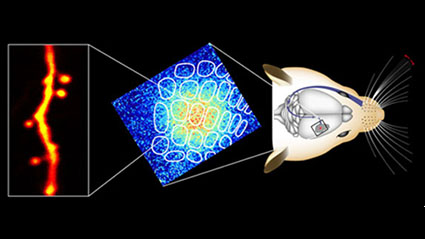The synaptic interactions driving the neural circuit computations underlying any goal-directed sensorimotor transformation
23 October 2013

The research undertaken by Prof. Carl Petersen and his group about the causal description of the synaptic interactions driving the neural circuit computations underlying any learned, goal-directed sensorimotor transformation is published in Nature Neuroscience.
Sensory perceptions are thought to be generated by the activity of neurons in the cerebral cortex. However, a causal description of the synaptic interactions driving the neural circuit computations underlying any learned, goal-directed sensorimotor transformation is currently lacking.
The laboratory explore the role of primary sensory cortex in the simplest possible perceptual task, stimulus detection. Mice were trained to detect single brief whisker stimuli and to report the perceived stimuli by licking a spout to obtain a reward. Optogenetic stimulation of the primary somatosensory barrel cortex readily substituted for whisker stimulation in both learning and execution of the detection task. Pharmacological inactivation of barrel cortex prevented detection and task execution. The barrel cortex therefore plays a causal role in this behavior. Electrophysiological patch clamp recordings performed on superficial (layer 2/3) barrel cortex neurons during task performance revealed that both synchronized, slow oscillatory brain states and desynchronized brain states were compatible with high performance. Whisker deflection evoked an early reliable sensory response, indifferent to task performance. A secondary late response accompanied by increased activity in excitatory neurons was enhanced on hit trials compared to misses. Optogenetic stimulation of parvalbumin-expressing inhibitory neurons was used to inactivate the barrel cortex with high temporal precision, revealing a causal role for the late excitatory response in the detection task.
The data reveal dynamic stimulus processing in sensory cortex during task performance, with an early sensory response reliably encoding the stimulus and later secondary activity contributing to driving the subjective percept as reported through licking.
Author : LSENS
Reference :
Shankar Sachidhanandam, Varun Sreenivasan, Alexandros Kyriakatos, Yves Kremer, Carl C H Petersen;
Membrane potential correlates of sensory perception in mouse barrel cortex.
Nature Neuroscience 16:1671-1677, Oct 2013. doi:10.1038/nn.3532 >
